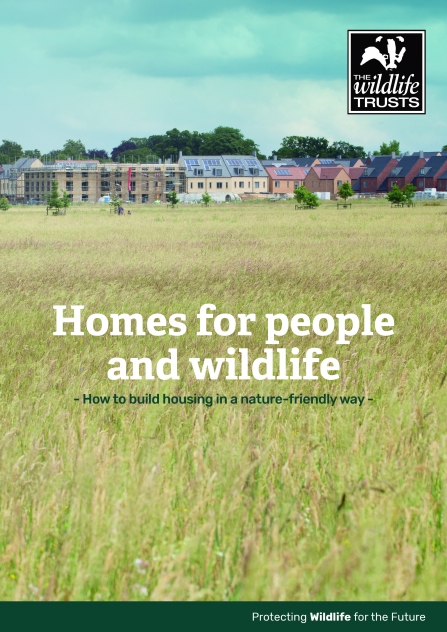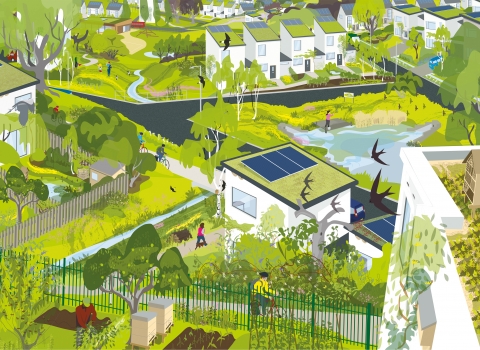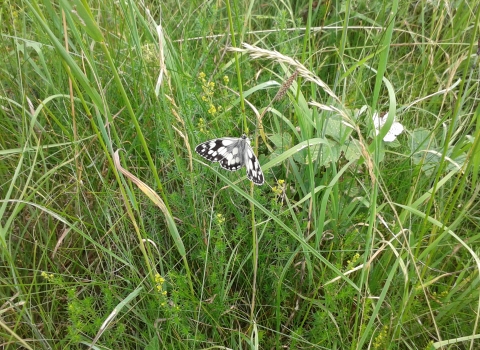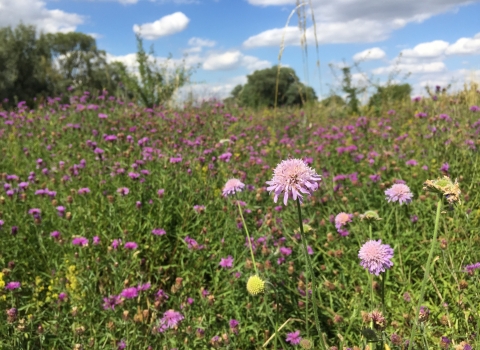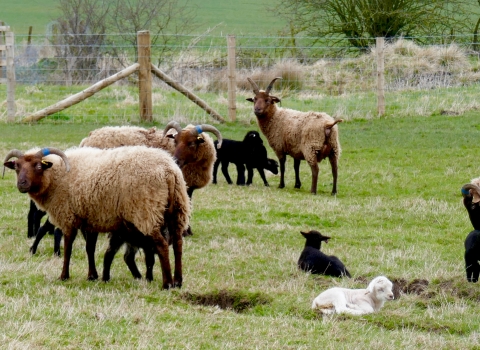Our region has been under tremendous pressure from housing and other development for the last 20 years, and we have to accept that it’s not going to get easier in the near future. So it's vital to ensure that any developments work in the best possible way for wildlife. A new national housing vision published Thursday 11 January by The Wildlife Trusts show how new developments can be built in a way that provides people with greener, inspirational homes which help to reverse decades of wildlife and habitat decline.
Homes for people and wildlife
Cambourne by Caroline Fitton
Homes for people and wildlife - how to build housing in a nature-friendly way is published at a time when the government has recently committed to building a further 1.5 million houses by 2022. The Wildlife Trusts believe that the natural environment must be at the heart of planning in order to give the government a chance of meeting its commitment to be the first generation to leave the environment in a better state than we found it, and to build new homes and communities that people enjoy living in.
Rachel Hackett, Living Landscapes Development Manager for The Wildlife Trusts says: 'A huge challenge lies ahead – thousands of new houses are to be built yet we need to restore the natural world. We’re calling on the government and local authorities to build beautiful, nature-friendly communities in the right places. Over the past century we have lost natural habitats on an unprecedented scale. Nature makes us happy and we depend on the things it gives us. Our new guidelines show that it’s possible to have both more wildlife and more housing, with good design the costs of doing this are a tiny proportion of the overall cost of a housing development, but represent a big investment for the future.'
Our new guidelines show that it’s possible to have both more wildlife and more housingThe Wildlife Trusts
The Trusts’ blueprint for new nature-friendly homes highlights the myriad of social, environmental and economic benefits of this approach:
- Benefits for wildlife – better protection for wildlife sites, more space for wildlife, improved connectivity and buildings that are more wildlife-friendly
- Benefits for residents – daily contact with nature, improved health, protection against climate extremes, safer transport routes, good sense of community
- Benefits for the economy and wider society – cost-effective environmental protection, employment, space to grow local food, healthier and happier communities putting less pressure on health and social services
- Benefits for developers – satisfied customers, market value, enhanced brand, improved recruitment, improved environmental ranking.
Twenty years from its inception, Cambourne in Cambridgeshire remains one of the best examples in the country, with 5,000 houses and more than 200 acres of wildlife habitat, which supports more skylarks, orchids, dragonflies and other wildlife that lived on the site when it was intensive arable farmland.
Brian Eversham, CEO of WT BCN says: ‘In Cambourne not only is the existing wildlife flourishing but many new species have colonised and will continue to do so as the site matures. There are several badger setts in the woods and hedgerows, and many of the ponds contain great crested newts. The woodlands are extremely rich in insect life with over 800 species having been recorded. Green and great spotted woodpeckers and bullfinches now breed here. The lakes have been colonized by water voles, reed buntings, coot, and a pair of mute swans, as well as being rich in dragonflies and other insects. In winter, there are flocks of finches and buntings, and regular sightings of snipe and stonechat.’
Best examples
In addition to Cambourne, the Trust has been involved in several other schemes across the region where development has benefited wildlife:
In south-west Cambridge, Trumpington Meadows (58ha) has greenspace in a single large block, rather than fitting between housing and business development. The landscape is zoned so the land closest to housing is formally managed, progressing to more wildlife-rich, cattle-grazed fields and riverside meadows and woodland to the south-west of the M11. The design ensures that the most wildlife-sensitive areas are protected from human impacts, and the site provides something for everyone.
The developers, Grosvenor, used seed-mixes for wildflower meadows which the Trust recommended, and which they then planted years before the first house was built. By the time the houses were occupied, the new habitats were developing well, and the Trust had dedicated staff on site, managing the nature reserve and working with local schools and communities.Rushden Lakes (40ha) in Northamptonshire is a retail and leisure development rather than housing, but the same principles apply: the developers provided land which links together four existing Trust nature reserves to form the Nene Wetlands (270ha). The developers LXB and The Crown Estate fund the management of the land by the Wildlife Trust, some of which is the most important wildlife habitat in the county. A newly created network of paths and bridges has increased access for visitors and the local community. The footprint of the retail development forms only one fifth of the overall area and is on former industrial derelict land, ecologically assessed as of very low wildlife value. In the heart of the development, a visitor centre has been provided, where the Trust engage with large numbers of people and demonstrate how wildlife is flourishing.
Lilbourne Meadows (78ha), on the western edge of Northamptonshire, not far from Rugby, is a logistics hub next to the M1. The developers Prologis are providing a large area of meadows suitable for breeding birds such as skylark, meadow pipit and curlew, and a network of hundreds of ponds for great crested newts and a purpose built bat house. Although the habitats are being created to mitigate for the warehouse development, they will also be accessible to new areas of housing nearby. The site is now managed by the Wildlife Trust BCN, paid for by the developer, who have also constructed barns and an office to support the conservation grazing of the site.
Remaining diligent
The Trust will work with developers where there are substantial benefits to wildlife and where important sites are not threatened. We will campaign to prevent damaging development. In the past we have successfully fought to prevent housing next to Flitwick Moor in Bedfordshire, a very sensitive spring-fed mire whose water supply could be catastrophically damaged by development. Proposals for a new village close to Castor Hanglands National Nature Reserve to the west of Peterborough are likewise unacceptable because of the threat they pose to one of the most valuable reserves in the region.

